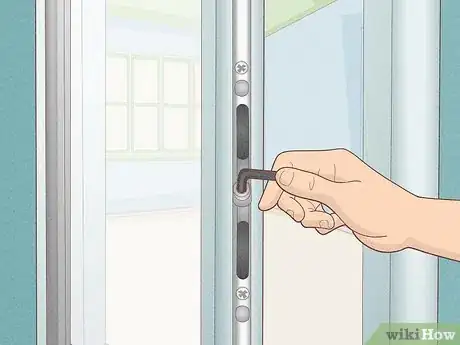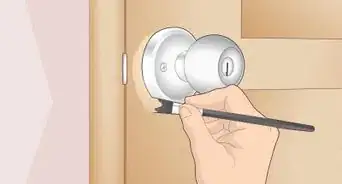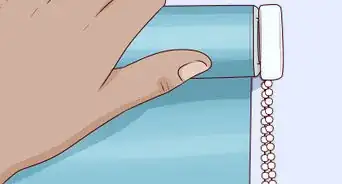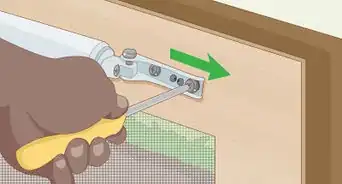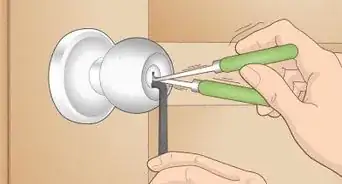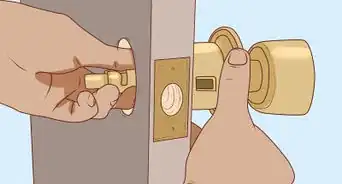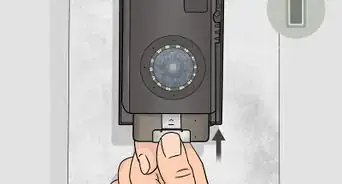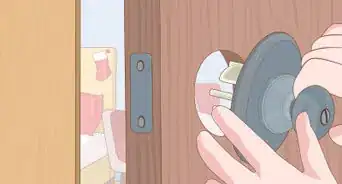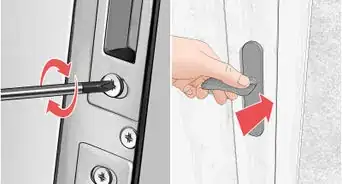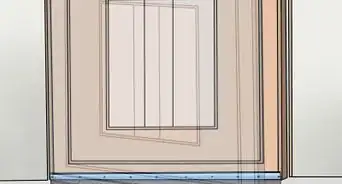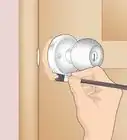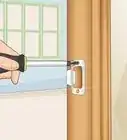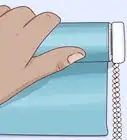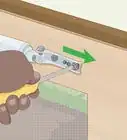This article was co-authored by wikiHow Staff. Our trained team of editors and researchers validate articles for accuracy and comprehensiveness. wikiHow's Content Management Team carefully monitors the work from our editorial staff to ensure that each article is backed by trusted research and meets our high quality standards.
There are 10 references cited in this article, which can be found at the bottom of the page.
This article has been viewed 188,223 times.
Learn more...
uPVC windows are generally a high-quality window model which doesn’t need much adjustment. uPVC windows typically have hinges and open up and outwards from the window frame (rather than traditional windows which slide upward within the window frame). If you’re noticing drafts around the sides or bottom of your window, you may need to adjust the screws on the inside of the window frame which raise or lower the height of the sash.
Steps
Adjusting the Height of the Window in the Frame
-
1Inspect the bottom of the sash to see if it fits in the frame. Open and close your uPVC window a few times. The bottom of the sash should slide smoothly into the window frame. If it doesn’t, but instead sticks against the frame or seal, the windows needs its height raised.[1]
- On the other hand, if your uPVC window sash doesn’t quite contact the window frame when shut, but rests about 1⁄16 inch (0.16 cm) above them, you’ll need to lower the window’s height.
- A window “sash” is the panel—typically made of multiple glass panes—which raises and lowers to open the window.
-
2Open the window completely. This will give you easy access to the small screws that you’ll need to loosen in order to alter the window’s height.[2]
- Since adjusting the window may take 15-20 minutes, plan to do it on a rain-free day.
Advertisement -
3Loosen the 4 screws holding the uPVC casement to the left side of the frame. Once the window is opened, you will see 4 small screws holding a metal strip to the window frame. Loosen each of these screws about 1 full turn.[3]
- The casement of a uPVC window is the metal strip which fastens directly to the wooden window frame. The hinges which allow the window to be opened and shut also attach to the casement.
- When adjusting the window’s height, do not loosen the screws holding the hinges to the frame.
-
4Loosen the screws holding the window casement to the right side of the frame. Now that you’ve loosened screws on one side of the casement, loosen the screws on the right-hand side of the frame. As you did before, turn each screw 1 full turn counterclockwise to loosen it.[4]
- All 8 of the screws holding the window sash to the casement will most likely take a large Phillips head screwdriver. If this doesn’t fit, test out different sizes of Phillips head until you find one that fits snugly into the screw.
-
5Press or lift the window sash to adjust the height. Once the 8 screws have been loosened, you will be able to raise or lower the height of the moveable window panel.[5] Move the window a small increment downward (if the window hasn’t been closing fully) or upward (if the window sticks against the frame when closing).
- You may need to support the weight of the window panel until the screws have been tightened again. If the panel is very heavy, it may be pulled downward under its own weight.
-
6Tighten the 8 screws once the sash has been adjusted. Once the window has been adjusted, give each of the 8 screws that you previously loosened a full turn clockwise to tighten them. Then, shut the window a few times to confirm that it opens and closes properly.
- At this point, your uPVC window should fit snugly into the frame when closed.[6] This will also stop any drafts that have been coming into your home through the unaligned window.
Adjusting the Lock Position for a Better Seal
-
1Open your uPVC window and find the lock-adjustment head. If your style of uPVC window opens outwards, rather than upwards, you can move the lock on the sash forwards or backwards. Look on the lower half of the open window sash, about halfway between the lock and the bottom of the sash.[7]
- Adjusting the position of the lock will help your window seal properly if the locked window has been lose and drafty or if the lock mechanism doesn’t quite catch and seal the window properly.
- This style of window is called a “long-bottom lock,” and the part that lets you adjust the lock’s position is called the “head.”
-
2Insert an Allen wrench into the lock head. On most brands of uPVC window, an Allen wrench is used to move the placement of the lock.[8]
- If you don’t already own Allen wrenches, you can purchase a set of them at a local hardware store.
-
3Turn the wrench clockwise or counterclockwise to move the lock backwards or forwards. Turning the wrench clockwise will move the lock backwards (farther out from the lock mechanism) and increase the pressure exerted on the window when locked. This will improve the seal and stop any drafts.[9]
- Turning the wrench counterclockwise will relax the pressure when the window is shut. Try this approach if your window hasn’t been locking fully, or requires a great deal of force to lock.
Community Q&A
-
QuestionMy UPVC sliding window is very hard to move. How do I adjust it?
 Drew Hawkins1Community AnswerTry opening up the window completely and loosening the 4 screws on the left and right side of the frame. Then, raise or lower the height of the panel to adjust it. Once you're finished, tighten all 8 of the screws so the window is held firmly in place and close it.
Drew Hawkins1Community AnswerTry opening up the window completely and loosening the 4 screws on the left and right side of the frame. Then, raise or lower the height of the panel to adjust it. Once you're finished, tighten all 8 of the screws so the window is held firmly in place and close it. -
QuestionHow do you fix a draughty uPVC window?
 Drew Hawkins1Community AnswerYou can try adjusting the lock position for a better seal. Open up the window and locate the lock-adjustment head. Use an Allen wrench to turn the lock backward to increase the pressure it exerts on the window when it's locked, which will create a tighter seal.
Drew Hawkins1Community AnswerYou can try adjusting the lock position for a better seal. Open up the window and locate the lock-adjustment head. Use an Allen wrench to turn the lock backward to increase the pressure it exerts on the window when it's locked, which will create a tighter seal. -
QuestionWhy is my uPVC window not closing properly?
 Drew Hawkins1Community AnswerYou may need to adjust the height of the window in the frame so it closes properly. Open the window up all the way and loosen the 4 screws on each side of the frame. Then move the window down a small amount and tighten all 8 of the screws. Close the window to see if it's fitting properly. You can make more adjustments as needed.
Drew Hawkins1Community AnswerYou may need to adjust the height of the window in the frame so it closes properly. Open the window up all the way and loosen the 4 screws on each side of the frame. Then move the window down a small amount and tighten all 8 of the screws. Close the window to see if it's fitting properly. You can make more adjustments as needed.
References
- ↑ https://youtu.be/7p_vsIlZ2ZQ?t=7s
- ↑ https://youtu.be/7p_vsIlZ2ZQ?t=29s
- ↑ https://youtu.be/7p_vsIlZ2ZQ?t=31s
- ↑ https://youtu.be/7p_vsIlZ2ZQ?t=1m17s
- ↑ https://youtu.be/7p_vsIlZ2ZQ?t=1m43s
- ↑ https://youtu.be/7p_vsIlZ2ZQ?t=2m1s
- ↑ https://youtu.be/w7WUp3bmg8c?t=24s
- ↑ https://youtu.be/w7WUp3bmg8c?t=36s
- ↑ https://youtu.be/w7WUp3bmg8c?t=40s
About This Article
If you want to adjust the height of a uPVC window in its frame, start by opening the window completely. On each side of the frame, you will see 4 small screws holding a metal strip to the wooden window frame. Loosen all 8 of these screws about 1 full turn, then carefully press or lift the window sash to adjust the height. Once the window has been adjusted, tighten the 8 screws to secure it in place. Alternatively, if you want to adjust the lock position of your uPVC window for a better seal, open the window and locate the lock-adjustment head. Then, insert the Allen wrench into the lock head and turn it clockwise, which will increase the pressure exerted on the window when it's locked. For more advice, including how to relax the pressure on your uPVC window lock, keep reading!







